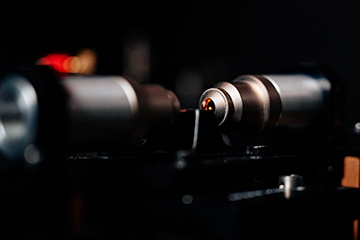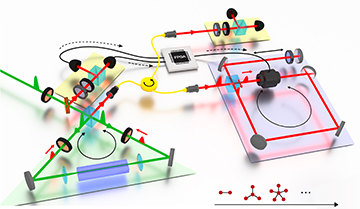
[Image: Paderborn University / B. Mazhiqi]
As the 2022 Nobel Prize in Physics underscored, the phenomenon of entanglement—the uncanny correlation of the states of distantly separated particles—lies at the center of today’s emerging quantum technologies. It follows that moving such technologies forward will require new ways to generate entangled photons quickly, dependably and scalably. That’s particularly true for large entangled states involving ensembles of three or many more photons, which underlie efforts to improve the reliability of quantum computing and the bandwidth and security of quantum communications.
Researchers at Paderborn University and the University of Ulm, Germany, have now prototyped a novel “assembly line” approach for building such multiphoton entangled states (Phys. Rev. Lett., doi: 10.1103/PhysRevLett.129.150501). The team reports that its method can tie together six photons in one prominent entangled-state variety—a so-called Greenberger-Horne-Zeilinger (GHZ) state—some 35 times faster than previous approaches, with no loss of state fidelity. According to the paper’s authors, the technique “brings into reach applications that exploit the power of large entangled states.”
A promising quantum resource
Entanglement of ensembles of photons beyond simple pairs, called multiphoton or multipartite entanglement, constitutes one route to achieving so-called high-dimensional entanglement. Researchers believe that such complex entangled states could give a boost to a variety of quantum technologies.
In communications, for example, multipartite entanglement could enable “quantum secret sharing,” allowing the efficient sharing of quantum-encrypted information across multiple parties, not just a pair. Large entangled states are essential to certain flavors of quantum computing, too—for example, so-called measurement-based or one-way quantum computing, which requires large “cluster states” of highly entangled quantum resources.
Time-consuming process
One well-known variety of a multipartite entangled state is the GHZ state, named for the physicists Daniel Greenberger, Michael Horne and 2022 Nobel physics laureate Anton Zeilinger. These maximally entangled states of three or more particles—important in the history of ideas on entanglement—also have potential practical applications in quantum information.
But building up GHZ and other multipartite entangled-photon states is an inherently probabilistic enterprise. For GHZ states, the typical method involves generating entangled “Bell pairs” that are detected, post-selected and fused with entangled pairs simultaneously generated by other photon sources. Since the photon sources themselves have a low probability of generating Bell pairs, it’s a time-consuming workflow—and the probability of success decreases exponentially the more photon pairs one tries to entangle. In 2018, for example, the group of Jian-Wei Pan at the University of Science and Technology, Hefei, China, offered an approach that could generate 12-photon GHZ states—but only at the rate of one such entangled state per hour.
Memory games
The team behind the new work, led by Christine Silberhorn of Paderborn University, has devised a setup that reportedly can build up GHZ states at rates that are blazingly fast relative to previous techniques. At the heart of the setup is a newly developed, programmable and switchable quantum memory.
The memory module—which includes a polarization beam splitter (PBS) and fast, programmable electro-optic modulators in an optical loop—can store an entangled photon of a detected Bell pair while the next Bell pair is being generated. At that point, it can switch to interfere and combine the stored photon with the newly detected entangled photon to create a higher-order entangled state.
The process enables large entangled states to be built up incrementally, in an assembly-line fashion. By removing the requirement that all entangled photons from multiple sources be created and detected simultaneously, the probability of success dramatically increases.
Heralds and signals
In the Silberhorn team’s experimental setup, “Bell pairs” of entangled photons (green area) are detected (yellow areas) and sent to a switchable memory module (red area), where they can be either stored or interfered with a previously stored entangled photon from a different Bell pair. The setup allows complex, multiphoton entangled states to be built up step by step. [Image: Silberhorn et al. / Paderborn University] [Enlarge image]
In the team’s setup (shown in the accompanying diagram), a periodically poled potassium titanyl phosphate (ppKTP) waveguide source of Bell pairs at telecom wavelengths (violet box) is pumped by a Ti:sapphire laser (green beam). Polarization-resolved detection of a “herald” photon in the entangled pair triggers a field-programmable gate array (FPGA) that toggles the quantum memory module into its storage mode. The entangled “signal” photon of the pair is then shunted into the memory module for storage.
Upon detection of the next Bell-pair herald, another electrical impulse is sent to the FPGA to put the memory module into its other operating mode, PBS interference. In this mode, the stored signal photon is interfered with the signal photon from the newly detected entangled pair. If the interference is successful, it creates a four-photon entangled state (that is, entanglement of the two detected Bell pairs), which itself can be stored until the next Bell pair becomes available to increase the number of entangled photons.
35-fold efficiency gain
According to the researchers, their “time-multiplexed, feed-forward” scheme with a single Bell-pair source was able to assemble six-photon GHZ states at a rate some 35 times faster than alternative techniques using multiple sources. And the advantage relative to other methods should actually increase as the number of entangled photons grows. Silberhorn’s team calculates, for example, that the method should be able to generate 12-photon GHZ states some three orders of magnitude faster than other approaches.
“Our system allows entangled states of increasing size to be gradually built up—which is much more reliable, faster and more efficient than any previous method,” Silberhorn said in a press release accompanying the research. “For us, this represents a milestone that puts us in striking distance of practical applications of large entangled states for useful quantum technologies.”


